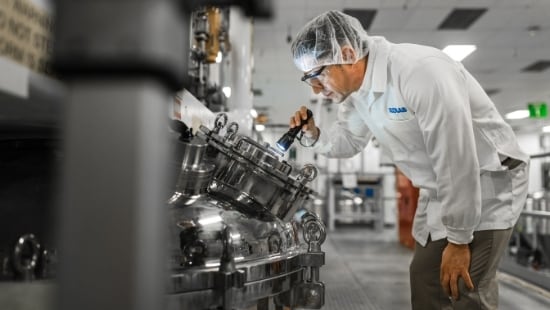Unseen, unnoticed and potentially deadly: Why we need to start talking about biofilms
What may look like clean food-making equipment could be covered in invisible bacterial colonies. Here’s how to maintain cleanliness and safety at your facility.

“I don’t see any biofilm in my facility, so it must not be a problem.” If that’s what you’re thinking, you should take a closer look. Biofilms can be hiding in the less visible bends and creases of your equipment. They’re often difficult to find, but they should never be ignored. Unaddressed, they can lead to serious – and costly – problems, including product spoilage, foodborne illness and production efficiency issues.
Let’s look at what biofilms are, how you can detect them, and how to reduce your risk.
A city of microbes
A biofilm is defined as a complex, structured community of bacteria and other microorganisms attached to a surface. These microorganisms undergo changes enabling them to survive and thrive in environments normally considered bacteria-resistant. Biofilms can form on just about any type of surface, including the plaque on your teeth. In a food and beverage manufacturing setting, we typically associate biofilms with drains, but they also can be found on filters, poorly designed equipment, uncleanable steam ports, air blow lines and other areas in a plant that are susceptible to inadequate cleaning and sanitizing.
Biofilm forms when microorganisms adhere to a surface. As these microorganisms replicate and form a colony, they create a protective barrier made up of mostly sugars and proteins. This protective barrier increases the microorganisms’ resistance to cleaning and sanitizing.
Signs you may have a biofilm risk
It’s a common misconception that if you don’t see biofilms on your surfaces, then you don’t have a biofilm problem. Biofilms typically propagate within nooks, crannies and hard-to-reach areas – no wonder they are hard to detect. Once they attach to a surface, they not only continue to grow, but they also become more resistant to the things that normally kill them, like heat or chemicals.
The following are signs that you may have a biofilm in your facility:
- Positive ATP test results: Adenosine triphosphate (ATP), is an indicator of life. Although it is not direct proof, where there is ATP, there might also be a biofilm.
- Testing: Sporadic quality failures or spikes in microbiological counts could be due to biofilms
- Odor: A sour smell is often an indicator of biofilms
- Visual Appearance: Biofilm appearance can range from slight equipment discoloration to a slimy/sticky substance attached to a surface.
Ways to reduce biofilm risk
Without realizing it, you may be creating environments conducive to biofilm growth. If you find biofilm activity, your best bet is to take a holistic approach to address it. The most effective approach to reduce biofilm formation is making sure your facility has a sound Food Safety and Quality System. However, you still may find challenges due to:
1) Lack of hygienic design: Ensure all equipment is designed to be cleanable, without deadlegs (i.e., areas that see little flow) or porous surfaces. If necessary, modify your equipment so it can be easily cleaned and sanitized
2) Insufficient preventive maintenance: Conduct preventive maintenance according to schedule. Biofilms can hide in harbor points like gaskets and valves. Adhering to your maintenance schedule is a good way to keep biofilm growth at bay
3) Lack of training: Create and maintain a non-negotiable robust cleaning and sanitizing program. Then stick to it no matter what and make sure your employees are doing what they have learned. It must happen, even when you have new staff, a tight schedule or when you’re on deadline.
To learn more about how Ecolab’s holistic, comprehensive approach to food safety can help you mitigate your own biofilm risk, contact your local Ecolab team member. www.ecolab.com/biofilms
Jesse Hines is a Microbiologist and Program Leader focusing on bringing Food Safety and Quality solutions to Ecolab’s Food and Beverage Customers.



